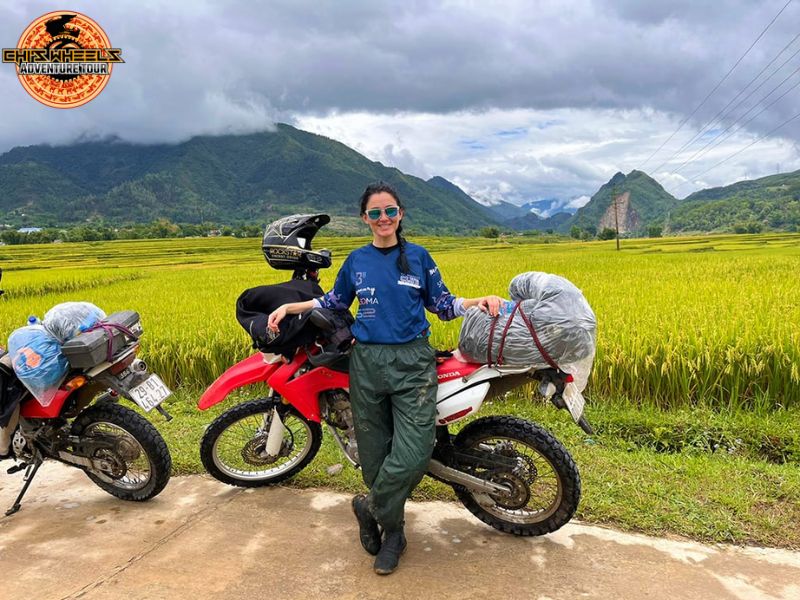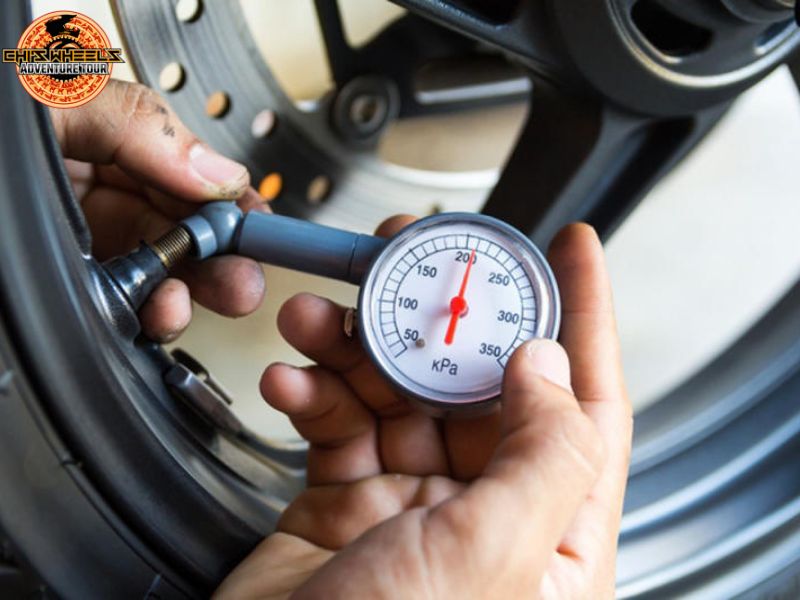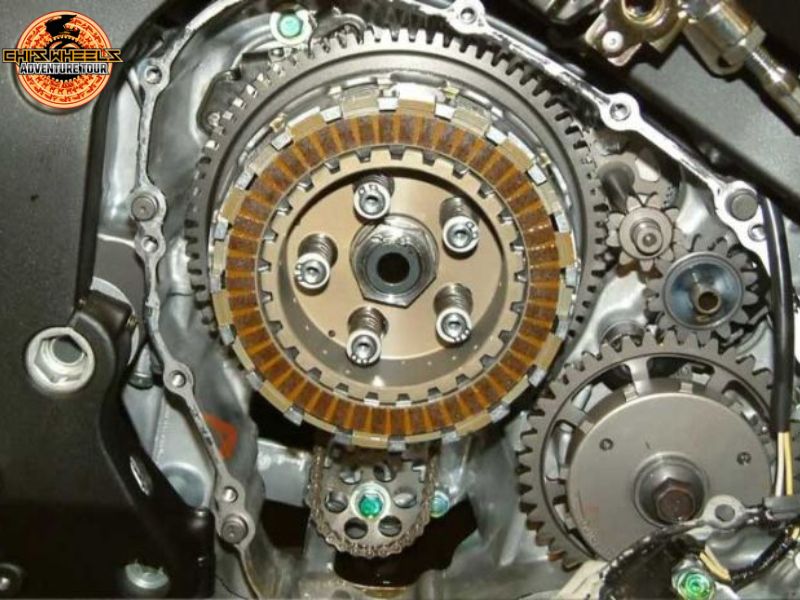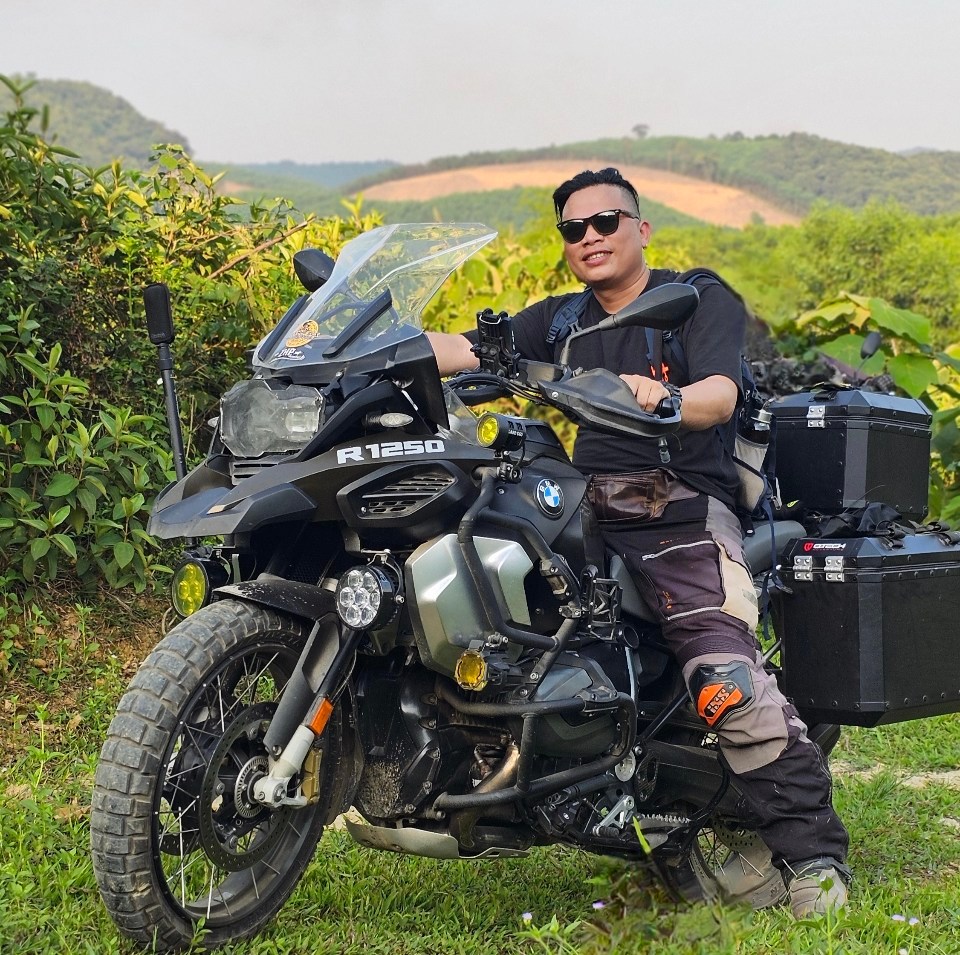Are you a beginner learning to ride a motorbike and not sure where to start? Don’t worry — this article will guide you step by step on how to ride a motorbike safely and confidently, from the most basic operations to the essential skills for road use. With the tips and experience compiled by Vietnammotorbiketour, you’ll quickly master the handlebars and fully enjoy your rides.
Wear full protective gear when riding a motorbike
When riding a motorbike, you have almost no protective barrier between your body and the surrounding environment. Therefore, wearing proper protective gear is essential to minimize injuries in case of an accident.
- Helmet: Choose a quality-certified helmet that fits snugly and doesn’t feel loose. Make sure it has a sturdy chin strap and allows for good visibility while riding.
- Eye and face protection: Use a shatter-resistant visor or windscreen to shield your eyes, nose, and mouth from dust, insects, and debris on the road. Check that it fits well and does not obstruct your view.
- Clothing: Wear long pants and a long-sleeved jacket made from durable, thick material to protect your body as much as possible. Pair them with gloves and high-ankle boots to protect your hands and feet from scratches or impact. Even when wearing multiple layers, ensure you can still move comfortably and control the motorbike with ease.

Understand all the symbols and control components of a motorbike
You won’t be able to ride a motorbike safely without understanding the function of each part. Below are the key components and controls you need to know:
- Handlebars: Located at the front of the bike, the handlebars allow you to steer the motorbike left or right.
- Throttle (accelerator): Found on the right handlebar, the throttle controls the speed of the motorbike. Twist it toward you to accelerate and release it gently to slow down.
- Front brake lever: Positioned in front of the throttle, also on the right handlebar. Squeeze it to slow down or stop the front wheel.
- Rear brake pedal: Usually located near the right footrest. Press it down with your foot to brake the rear wheel.
- Clutch lever: Located on the left handlebar, opposite the front brake lever. Pull the clutch when shifting gears and release it smoothly to allow the engine to engage.
- Gear shifter: Found near the left footrest, it lets you change gears by lifting or pressing down with your foot.
- Ignition switch: Used to turn the electrical system on or off. You must switch it on before starting the engine.
- Electric starter button: Located on the right handlebar near the throttle. After turning on the ignition, press this button to start the engine.

Inspect your motorbike before riding
Regularly inspecting your motorbike helps ensure it stays in good condition and keeps you safe on the road. You should perform routine checks weekly and before every ride. Here are the key items to pay attention to:
- Tires: Check tire pressure and tread wear. Properly inflated tires provide better control and stability.
- Engine oil and other fluids: Make sure the engine oil, brake fluid, and other necessary fluids are at appropriate levels.
- Headlight, tail light, and turn signals: Ensure all lights work properly and that no bulbs are burned out.
- Brake light: Test each brake to confirm the brake light illuminates when applied.
- Battery: Make sure the battery is charged, secure, and functioning properly (you can jump-start it if needed).
- Chain or belt: Check for correct tension and proper lubrication to prevent slippage or damage.
- Clutch and throttle: Both should operate smoothly. The throttle should automatically return to its idle position after being released.
- Mirrors: Adjust both rearview mirrors to clearly see behind and on both sides.
- Brakes: Test the front and rear brakes separately to ensure the bike stays steady and stops when fully applied.
- Horn: Verify that the horn works properly so you can use it when necessary.

How to mount a motorbike properly
After preparing everything and understanding the basic operation of the motorbike, you can start mounting it. If the bike has a kickstand, stand on the left side of the motorbike, holding the handlebar firmly with one hand and the seat or the other handlebar with your other hand for balance. Use your foot to push the kickstand up and hold the bike in an upright position. Always make sure the kickstand is fully retracted before starting your ride.
Starting the motorbike engine
This is the step that prepares your motorbike for operation. Depending on the manufacturer and the type of bike (manual, scooter, or clutch bike), the starting process may vary slightly. However, the basic procedure is usually as follows:
- Turn on the ignition switch: Insert the key and turn it to the ON position to activate the bike’s electrical system. For some scooters or bikes equipped with an anti-theft system, you may need to unlock remotely or enter a security code first.
- Shift to neutral gear: Make sure the bike is in neutral (N) to prevent it from jumping forward when starting. For scooters, just ensure the kickstand is up.
- Pull the clutch/brake and press the starter button: Hold the clutch or brake lever for safety, then press the starter button to start the engine. Some older models may require you to kick-start if the electric starter is weak.
Tip: If the bike hasn’t been started for a while, turn on the ignition and twist the throttle gently a few times before pressing the starter. This helps distribute fuel evenly into the carburetor, making ignition easier.

Identify the position of the brakes and throttle
Before you start moving, you need to clearly identify the positions of the throttle, front brake, and rear brake — the controls you’ll use most often while riding:
- Throttle: Located on the right handlebar, it controls the bike’s speed. Twist it toward you to accelerate and release it to slow down.
- Front brake: Positioned just in front of the throttle on the right handlebar. Squeeze it to slow down or stop the front wheel.
- Rear brake: Found near the right footrest, it is operated by pressing down with your foot to slow or stop the rear wheel.
Memorizing and mastering these controls is essential for maintaining safety and confidence while riding.

Using the clutch and shifting gears
For manual or semi-automatic motorbikes, you need to pull the clutch each time you shift gears. The gear shifting should be coordinated with the bike’s speed:
- Shifting up: When the bike is gaining speed or moving faster.
- Shifting down: When the bike slows down or comes to a complete stop.
Basic gear shifting technique:
- Fully pull the clutch lever: Use your left hand to pull the clutch lever all the way in to disconnect the engine power from the transmission.
- Move the gear lever: Use your left foot to shift the gear lever up or down, depending on the gear you need. You’ll hear a small “click” sound when the gear engages properly.
- Release the clutch gradually: As you slowly release the clutch lever, gently twist the throttle at the same time to let the bike accelerate smoothly.
Note when downshifting: Shifting to a lower gear can be more difficult than shifting up. If you don’t coordinate the clutch and throttle smoothly, the bike may jerk or skid. To avoid this, always downshift only after the engine speed has decreased to match the bike’s current speed. This helps maintain balance and ensures a smoother, safer ride.

Practicing safe motorbike turns
Beginners should be especially careful when making turns. Entering a corner too quickly can cause you to drift into another lane or even slide off the road. On the other hand, braking suddenly while turning can make the wheels slip and cause loss of control.
To turn a motorbike safely, you need to practice regularly and remember these steps:
- Reduce speed: Before turning, release the throttle or brake gently to slow down.
- Look in the direction you want to turn: Turn your head only, while keeping your body and shoulders steady.
- Lean the bike correctly: For sharp or fast turns, lean the bike more to maintain balance. For slow turns, a gentle lean is enough. Avoid braking while turning to prevent loss of control.
- Maintain a steady speed: Once in the turn, keep a consistent speed; you can gently twist the throttle to exit the corner smoothly and safely.

Practicing how to stop a motorbike
To stop a motorbike effectively and safely, you need to coordinate both braking and downshifting:
- Use both brakes: The front brake provides up to 75% of the braking force, but you shouldn’t rely on just one brake. Squeeze the front brake and press the rear brake simultaneously for a stable and controlled stop.
- Downshift: While braking, shift to lower gears to match your current speed. This helps prevent jerking and keeps the bike ready to move again when needed.
- Maintain balance: Once the bike comes to a complete stop, keep both brakes engaged and place your left foot on the ground to keep the bike steady.
Note: You can slow down by downshifting and releasing the throttle, but this method won’t activate the brake light. Always squeeze or press the brake to turn on the brake light, allowing vehicles behind you to notice that you’re slowing down.
Identify the correct lane position
Motorbikes are much smaller than cars, trucks, or SUVs, giving you more flexibility in choosing your position within a lane. However, there isn’t a single “correct” position that works for every situation.
Note: Choose a lane position that allows you to see clearly and ensures that other drivers can see you easily. This includes:
- Avoiding blind spots of cars or trucks.
- Maintaining a safe distance from the vehicle in front and those beside you.
- When riding in the middle of the lane, watch out for obstacles or vehicles turning so you can react in time.

Take a local motorbike riding course
Reading theoretical guides can’t replace hands-on instruction from a professional. If you’re serious about learning to ride a motorbike or preparing for a driving test, consider enrolling in a local motorbike riding school.
Here, you will:
- Receive proper training in essential riding skills.
- Practice real-life situations under the guidance of experienced instructors.
- Learn how to ride safely when carrying a passenger or riding in a group.
For many people, long motorbike trips with friends are an unforgettable experience. However, group riding also comes with higher risks. Therefore, before hitting the road, take time to learn safe group riding tips to ensure a smoother and safer journey for everyone.

Riding a motorbike is not only a practical skill but also gives you the freedom and excitement of exploring every journey. However, to ride safely and confidently in traffic, you need to master the basic steps — from preparing protective gear and inspecting your bike to understanding the controls, as well as practicing safe turning, stopping, and lane positioning techniques.
Vietnammotorbiketour hopes that these insights will help you soon gain full control of your motorbike and enjoy every trip to the fullest — safely, confidently, and with great enthusiasm.












